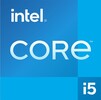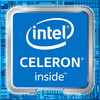Intel Core i5-1250P vs Intel Celeron 3867U vs Intel Celeron 3965Y
Intel Core i5-1250P
► remove from comparison
The Intel Core i5-1250P is a mid-range Alder Lake-P family SoC designed for use in ultra-light, ultra-thin (yet actively cooled) laptops. It was announced in early 2022 and it has 4 performance cores, as opposed to the 6 cores of the top-of-the-line i7-1280P (P-cores, Golden Cove architecture) mated to 8 efficient cores (E-cores, Gracemont architecture). The i5's P-cores are Hyper-Threading-enabled for a total of 16 threads when combined with its E-cores. The clock speeds range from 1.7 GHz to 4.4 GHz for the performance cluster and 1.2 GHz to 3.3 GHz for the efficient cluster. The shortcomings of this processor as compared with the slightly faster Core i5-1260P include the smaller L3 cache, slower iGPU model, lower clock speeds. Full vPro feature set is enabled in the case of this i5, though ("Enterprise" tier, allowing for remote device management).
Architecture
The i5 is a continuation of Intel's efforts to use the ARM-developed big.LITTLE technology for its own benefit. A single "little" Alder Lake core is supposed to be as fast as a Skylake core (as found in the venerable Core i7-6700HQ among other options) which is six years old at this point. All of Core i5-1250P's CPU cores enjoy access to 12 MB of L3 cache. The integrated memory controller supports various memory types up to LPDDR5-5200, DDR5-4800, LPDDR4x-4267 or DDR4-3200; Intel recommends using no more than 64 GB, for reference. Just like the other 12th Gen Intel Core processors, this Core i5 comes with the Thread Director which is a new functionality designed to help Windows 11 decide which cores to use for what workload for best performance and efficiency possible. Hardware acceleration of AI algorithms is supported via GNA 3.0 and DL Boost (via AVX2). The alluringly fast PCI-Express 5.0 spec has not found its way into Alder Lake P processors, so users will have to be content with PCI-Express 4.0 for the time being. Four PCI-Express 4 lanes allow for a read/write rate of up to 7.9 GB/s, provided a suitably fast NVMe SSD is used.
Please note this is not a user-replaceable CPU. It gets permanently soldered on to the motherboard (FCBGA1744 socket interface).
Performance
The average 1250P in our database nearly matches the Ryzen 5 5500U and the Ryzen 5 PRO 6650U in multi-thread performance, trailing behind the Core i5-1240P just slightly. This is a great CPU for nearly all tasks imaginable, as long as one does not expect it to be as fast as the mighty Core i7-12700H.
Your mileage may vary depending on how high the Power Limits are and how competent the cooling solution of your system is. The latter is really important as a single Golden Cove core can eat more than 20 W when under heavy load.
Graphics
The built-in graphics adapter in the form of the 80 EU Iris Xe running at up to 1.4 GHz has seen little change from what was built into certain 11th Gen Tiger Lake UP3 processors, like a Core i5-1135G7, which is hardly a downside as this iGPU is loaded with modern features, AV1 video decoding capability and SUHD 4320p monitor support included. The Xe isn't a stranger to a bit of casual gaming; that said, your mileage may vary depending on how high the Power Limits are and how capable the cooling solution of a laptop is. Expect something close to NVIDIA's MX250 or in other words, acceptable framerates in most games when playing at 1080p / Low settings. Fast RAM is a prerequisite for decent performance as the Xe has to make do with no dedicated video memory.
Power consumption
The i5's base power consumption (also known as the default TDP or Power Limit 1) is 28 W; its maximum Turbo power consumption (also known as the PL2) is not supposed to exceed 64 W. As for the "Minimum Assured" power consumption, Intel's guidelines mention 20 W. All in all, an active cooling solution is a must for a CPU like this.
The i5-1250P is built with Intel's fourth-gen 10 nm manufacturing process marketed as Intel 7 for decent, as of late 2022, energy efficiency. Despite that, the i5 is more power-hungry than certain 7 nm U-class AMD Ryzen 5000 chips delivering similar, or even higher, performance.
Intel Celeron 3867U
► remove from comparison
The Intel Celeron 3865U is an ULV (ultra low voltage) dual-core SoC based on the Kaby-Lake architecture and has been launched in the first quarter of 2017. The CPU can be found in ultrabooks as well as normal notebooks. In addition to two CPU cores clocked at 1.8 GHz (no Turbo Boost, no HyperThreading), the chip also integrates an HD Graphics 610 GPU and a dual-channel DDR4-2133/DDR3L-1600 memory controller. The SoC is manufactured using a 14 nm process with FinFET transistors.
Compared to the similar Celeron 3865, the 3867 offers a different cTDP-down option (12.5 versus 10 Watt).
Architecture
Intel basically uses the same micro architecture compared to Skylake, so the per-MHz performance does not differ. The manufacturer only reworked the Speed Shift technology for faster dynamic adjustments of voltages and clocks, and the improved 14nm process allows much higher frequencies combined with better efficiency than before.
Performance
Due to the missing Turbo Boost and the low clock speeds, especially the single thread performance is very limited which results in a lower performance even for lower demanding tasks. The performance should be noticeably slower than the Celeron 3965 which offers 400 MHz higher clocked CPU cores. Therefore, the CPU is only suited for entry level tasks like office, web surfing and multimedia.
Graphics
The integrated graphics unit called HD Graphics 610 (similar to the HD Graphics 510) represents the "GT1" version of the Kaby Lake GPU (Intel Gen. 9). Its 12 Execution Units, also called EUs, are clocked at 300 - 900 MHz and offer a performance somewhat below the older HD Graphics 4400. Only a few games of 2015 can be played smoothly in lowest settings.
Power Consumption
Specified at a TDP of 15 W (including CPU, GPU and memory controller), the CPU is best suited for small notebooks and ultrabooks (11-inches and above). Optionally, the TDP can be lowered to 10 watts (cTDP down), reducing both heat dissipation and performance and allowing even more compact designs.
Intel Celeron 3965Y
► remove from comparison
The Intel Celeron 3965Y is a low power entry level processor for small laptops or tablets and based on the Kaby Lake architecture. It was announced in Q2 2017 and offers two processor cores clocked at 1.5 GHz (no Turbo Boost). Compared to the Pentium 4410Y, the Celeron 3965Y offers no HyperThreading and therefore can execute only up to two threads simultaneously. The chips also includes the Intel HD Graphics 615 GPU, a dual-channel memory controller (DDR3L/LPDDR3) as well as VP9 and H.265 video de- and encoder. It is still produced in a 14 nm process with FinFET transistors. Currently (2017) it is the slowest Kaby-Lake based processor.
Architecture
Intel basically used the familiar micro architecture from the Skylake generation, so the per-MHz performance is identical. Only the Speed-Shift technology for faster dynamic adjustments of the voltages and clocks was improved, and the matured 14 nm process now also enables much higher frequencies and better efficiency than before.
Performance
Due to the missing HyperThreading, the Celeron 3965Y is slightly slower than the similar clocked Pentium 4410Y in some multi threaded benchmarks. The single thread performance is due to the missing Turbo Boost significantly worse than the more expensive Core m3-7Y30. This should be noticeable in daily tasks.
Graphics
The integrated Intel HD Graphics 615 GPU has 24 Execution Units (EUs) like the old HD Graphics 515 and runs with clocks between 300 and 850 MHz in combination with this processor. The performance heavily depends on the TDP limit as well as the memory configuration; with fast LPDDR3-1866 RAM in dual-channel mode, the GPU should sometimes be able to compete with the HD Graphics 520, but can also be much slower in other scenarios. Modern games from 2016 will, if at all, only run smoothly in the lowest settings.
Contrary to Skylake, Kaby Lake now also supports hardware decoding for H.265/HEVC Main10 with a 10-bit color depth as well as Google's VP9 codec.
Power Consumption
The chip is manufactured in an improved 14 nm process with FinFET transistors, so the power efficiency was once again improved significantly. The TDP is rated at 6 Watt and can be reduced to 4,5 Watt (cTDP down).
| Model | Intel Core i5-1250P | Intel Celeron 3867U | Intel Celeron 3965Y | ||||||||||||||||||||||||||||||||||||||||||||||||||||||||||||||||||||||||||||||||||||||||||||||||||||||||||||||||||||||||||||||||||||||||||||||||||||||||||||||||||||||||||||||||||||||||||||||||||||||||||||||||||||||||||||||||||||||||||||||||||||||||||||||||||||||||||||||||||||||||||||||||||||||||||||||||||||||||||||||||||||||||||||||||||||||||||||||||||||||||
| Codename | Alder Lake-P | Kaby Lake | Kaby Lake | ||||||||||||||||||||||||||||||||||||||||||||||||||||||||||||||||||||||||||||||||||||||||||||||||||||||||||||||||||||||||||||||||||||||||||||||||||||||||||||||||||||||||||||||||||||||||||||||||||||||||||||||||||||||||||||||||||||||||||||||||||||||||||||||||||||||||||||||||||||||||||||||||||||||||||||||||||||||||||||||||||||||||||||||||||||||||||||||||||||||||
| Series | Intel Alder Lake-P | Intel Kaby Lake | Intel Kaby Lake | ||||||||||||||||||||||||||||||||||||||||||||||||||||||||||||||||||||||||||||||||||||||||||||||||||||||||||||||||||||||||||||||||||||||||||||||||||||||||||||||||||||||||||||||||||||||||||||||||||||||||||||||||||||||||||||||||||||||||||||||||||||||||||||||||||||||||||||||||||||||||||||||||||||||||||||||||||||||||||||||||||||||||||||||||||||||||||||||||||||||||
| Series: Kaby Lake Kaby Lake |
|
|
| ||||||||||||||||||||||||||||||||||||||||||||||||||||||||||||||||||||||||||||||||||||||||||||||||||||||||||||||||||||||||||||||||||||||||||||||||||||||||||||||||||||||||||||||||||||||||||||||||||||||||||||||||||||||||||||||||||||||||||||||||||||||||||||||||||||||||||||||||||||||||||||||||||||||||||||||||||||||||||||||||||||||||||||||||||||||||||||||||||||||||
| Clock | 1200 - 4400 MHz | 1800 MHz | 1500 MHz | ||||||||||||||||||||||||||||||||||||||||||||||||||||||||||||||||||||||||||||||||||||||||||||||||||||||||||||||||||||||||||||||||||||||||||||||||||||||||||||||||||||||||||||||||||||||||||||||||||||||||||||||||||||||||||||||||||||||||||||||||||||||||||||||||||||||||||||||||||||||||||||||||||||||||||||||||||||||||||||||||||||||||||||||||||||||||||||||||||||||||
| L1 Cache | 1.1 MB | 128 KB | 128 KB | ||||||||||||||||||||||||||||||||||||||||||||||||||||||||||||||||||||||||||||||||||||||||||||||||||||||||||||||||||||||||||||||||||||||||||||||||||||||||||||||||||||||||||||||||||||||||||||||||||||||||||||||||||||||||||||||||||||||||||||||||||||||||||||||||||||||||||||||||||||||||||||||||||||||||||||||||||||||||||||||||||||||||||||||||||||||||||||||||||||||||
| L2 Cache | 10 MB | 512 KB | 512 KB | ||||||||||||||||||||||||||||||||||||||||||||||||||||||||||||||||||||||||||||||||||||||||||||||||||||||||||||||||||||||||||||||||||||||||||||||||||||||||||||||||||||||||||||||||||||||||||||||||||||||||||||||||||||||||||||||||||||||||||||||||||||||||||||||||||||||||||||||||||||||||||||||||||||||||||||||||||||||||||||||||||||||||||||||||||||||||||||||||||||||||
| L3 Cache | 12 MB | 2 MB | 2 MB | ||||||||||||||||||||||||||||||||||||||||||||||||||||||||||||||||||||||||||||||||||||||||||||||||||||||||||||||||||||||||||||||||||||||||||||||||||||||||||||||||||||||||||||||||||||||||||||||||||||||||||||||||||||||||||||||||||||||||||||||||||||||||||||||||||||||||||||||||||||||||||||||||||||||||||||||||||||||||||||||||||||||||||||||||||||||||||||||||||||||||
| Cores / Threads | 12 / 16 | 2 / 2 | 2 / 2 | ||||||||||||||||||||||||||||||||||||||||||||||||||||||||||||||||||||||||||||||||||||||||||||||||||||||||||||||||||||||||||||||||||||||||||||||||||||||||||||||||||||||||||||||||||||||||||||||||||||||||||||||||||||||||||||||||||||||||||||||||||||||||||||||||||||||||||||||||||||||||||||||||||||||||||||||||||||||||||||||||||||||||||||||||||||||||||||||||||||||||
| TDP | 28 Watt | 15 Watt | 6 Watt | ||||||||||||||||||||||||||||||||||||||||||||||||||||||||||||||||||||||||||||||||||||||||||||||||||||||||||||||||||||||||||||||||||||||||||||||||||||||||||||||||||||||||||||||||||||||||||||||||||||||||||||||||||||||||||||||||||||||||||||||||||||||||||||||||||||||||||||||||||||||||||||||||||||||||||||||||||||||||||||||||||||||||||||||||||||||||||||||||||||||||
| Technology | 10 nm | 14 nm | 14 nm | ||||||||||||||||||||||||||||||||||||||||||||||||||||||||||||||||||||||||||||||||||||||||||||||||||||||||||||||||||||||||||||||||||||||||||||||||||||||||||||||||||||||||||||||||||||||||||||||||||||||||||||||||||||||||||||||||||||||||||||||||||||||||||||||||||||||||||||||||||||||||||||||||||||||||||||||||||||||||||||||||||||||||||||||||||||||||||||||||||||||||
| max. Temp. | 100 °C | 100 °C | 100 °C | ||||||||||||||||||||||||||||||||||||||||||||||||||||||||||||||||||||||||||||||||||||||||||||||||||||||||||||||||||||||||||||||||||||||||||||||||||||||||||||||||||||||||||||||||||||||||||||||||||||||||||||||||||||||||||||||||||||||||||||||||||||||||||||||||||||||||||||||||||||||||||||||||||||||||||||||||||||||||||||||||||||||||||||||||||||||||||||||||||||||||
| Socket | BGA1744 | BGA | FCBGA1515 | ||||||||||||||||||||||||||||||||||||||||||||||||||||||||||||||||||||||||||||||||||||||||||||||||||||||||||||||||||||||||||||||||||||||||||||||||||||||||||||||||||||||||||||||||||||||||||||||||||||||||||||||||||||||||||||||||||||||||||||||||||||||||||||||||||||||||||||||||||||||||||||||||||||||||||||||||||||||||||||||||||||||||||||||||||||||||||||||||||||||||
| Features | DDR4-3200/LPDDR4x-4266/DDR5-4800/LPDDR5-5200, PCIe 4, Thr. Director, DL Boost, GNA, Remote Platform Erase, MMX, SSE, SSE2, SSE3, SSSE3, SSE4.1, SSE4.2, AVX, AVX2, BMI2, ABM, FMA, ADX, SMEP, SMAP, EIST, TM1, TM2, HT, Turbo, SST, AES-NI, RDRAND, RDSEED, SHA | Dual-Channel LPDDR3-1866/DDR4-2133/DDR3L-1600 Memory Controller, HyperThreading, AVX, AVX2, Quick Sync, Virtualization, AES-NI | Dual-Channel DDR3L-1600/LPDDR3-1866 Memory Controller, HyperThreading, AVX, AVX2, Quick Sync, Virtualization, AES-NI, TXT | ||||||||||||||||||||||||||||||||||||||||||||||||||||||||||||||||||||||||||||||||||||||||||||||||||||||||||||||||||||||||||||||||||||||||||||||||||||||||||||||||||||||||||||||||||||||||||||||||||||||||||||||||||||||||||||||||||||||||||||||||||||||||||||||||||||||||||||||||||||||||||||||||||||||||||||||||||||||||||||||||||||||||||||||||||||||||||||||||||||||||
| iGPU | Intel Iris Xe Graphics G7 80EUs ( - 1400 MHz) | Intel HD Graphics 610 (300 - 900 MHz) | Intel HD Graphics 615 (300 - 850 MHz) | ||||||||||||||||||||||||||||||||||||||||||||||||||||||||||||||||||||||||||||||||||||||||||||||||||||||||||||||||||||||||||||||||||||||||||||||||||||||||||||||||||||||||||||||||||||||||||||||||||||||||||||||||||||||||||||||||||||||||||||||||||||||||||||||||||||||||||||||||||||||||||||||||||||||||||||||||||||||||||||||||||||||||||||||||||||||||||||||||||||||||
| Architecture | x86 | x86 | x86 | ||||||||||||||||||||||||||||||||||||||||||||||||||||||||||||||||||||||||||||||||||||||||||||||||||||||||||||||||||||||||||||||||||||||||||||||||||||||||||||||||||||||||||||||||||||||||||||||||||||||||||||||||||||||||||||||||||||||||||||||||||||||||||||||||||||||||||||||||||||||||||||||||||||||||||||||||||||||||||||||||||||||||||||||||||||||||||||||||||||||||
| Announced | |||||||||||||||||||||||||||||||||||||||||||||||||||||||||||||||||||||||||||||||||||||||||||||||||||||||||||||||||||||||||||||||||||||||||||||||||||||||||||||||||||||||||||||||||||||||||||||||||||||||||||||||||||||||||||||||||||||||||||||||||||||||||||||||||||||||||||||||||||||||||||||||||||||||||||||||||||||||||||||||||||||||||||||||||||||||||||||||||||||||||||
| Manufacturer | ark.intel.com | ark.intel.com | ark.intel.com | ||||||||||||||||||||||||||||||||||||||||||||||||||||||||||||||||||||||||||||||||||||||||||||||||||||||||||||||||||||||||||||||||||||||||||||||||||||||||||||||||||||||||||||||||||||||||||||||||||||||||||||||||||||||||||||||||||||||||||||||||||||||||||||||||||||||||||||||||||||||||||||||||||||||||||||||||||||||||||||||||||||||||||||||||||||||||||||||||||||||||
| $107 U.S. |
Benchmarks
Average Benchmarks Intel Core i5-1250P → 0% n=0
Average Benchmarks Intel Celeron 3867U → 0% n=0
Average Benchmarks Intel Celeron 3965Y → 0% n=0
* Smaller numbers mean a higher performance
1 This benchmark is not used for the average calculation













